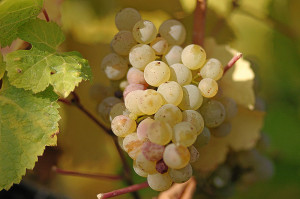The “Who’s Your Daddy” series takes a very brief look at the parentage of grapes, in order to get a better understanding of where particular varietals come from and how they are genetically related to one another. So far, we’ve covered: Cabernet Sauvignon, Chardonnay, Gamay, Merlot, Nebbiolo, Petite Sirah, Petit Verdot, Pinotage, Pošip bijeli, Sangiovese, Syrah, Tempranillo, Torrentés riojano, Gaglioppo di Cirò, and also the grapes from the USDA grape germplasm collection. Feel free to click on any one of the varietal names to read all about their parentage.
From my recent SpeakEasy interview with Jameson Fink from The Grape Collective, I had described my thoughts on what was the most important issue facing the wine industry today. I answered in part;
“… the issue of increasing biodiversity of wine grapes is extremely important. As global climate continues to change, some grape cultivars will probably not survive or the areas where these varieties
![Photo By Rosenzweig (Own work (own picture)) [GFDL (http://www.gnu.org/copyleft/fdl.html) or CC-BY-SA-3.0-2.5-2.0-1.0 (http://creativecommons.org/licenses/by-sa/3.0)], via Wikimedia Commons](http://www.academicwino.com/wp-content/uploads/2014/06/Muller-thurgau-the-academic-wino-300x199.jpg)
Photo By Rosenzweig (Own work (own picture)) [GFDL (http://www.gnu.org/copyleft/fdl.html) or CC-BY-SA-3.0-2.5-2.0-1.0 (http://creativecommons.org/licenses/by-sa/3.0)], via Wikimedia Commons
….. let’s start by purchasing more “unknown” types of wine instead of our “old standbys”. Let’s create the demand for biodiversity by seeking out and purchasing those wines made from grapes you’ve never heard of.”
So, in an effort to garner some publicity from some of these lesser known varieties and hopefully encourage people to go out and support these producers, I plan to steer this Who’s Your Daddy series toward those such grapes.
Without further ado, the subject of today’s “Who’s Your Daddy” post is Müller-Thurgau, a white variety hailing from Germany.
Brief History
While some of my German readers or European readers in general might recognize the name Müller-Thurgau, it’s certainly a type of grape/wine that is for the most part unknown to the average American consumer, as well as consumers from elsewhere around the globe. Müller-Thurgau is also known to be grown in Hungary, Austria, and the Czech Republic.
Müller-Thurgau was created in 1882 by Hermann Müller from the Swiss Canton of Thurgau at the research institute in Geisenheim . Playing an important role in post-war reinvigoration of German agricultural industry, Müller-Thurgau was quite popular until it had been surpassed in preference and sales by the more well-known Riesling grape. In fact, there was such a change in taste preference among the Germans around the 1980s that since that time, plantings of the grape have decreased.Viticulture/Winemaking
An early-ripening variety, Müller-Thurgau has medium to large sized grape clusters with a medium density. The cluster shape is cylindrical, with berries oval shaped and greenish-yellow tinted.
Müller-Thurgau is known for being a relatively “easy” grape to grow, insofar as it can grow under a wide range of growing conditions—it’s not too picky. This bodes well for areas not traditionally known for their wine industry, providing a possible opportunity for development and expansion into new wine regions as a result of the mounting pressures applied by climate change.
While it’s not picky, it can’t grow just any old place. Müller-Thurgau prefers soils that are deep with decent water retention capabilities. A bit of warning to grape growers—this variety is susceptible to peronospora, oidium, berry rot, and stem rot, so precautions need be taken if these diseases are known to occur in your area.
Tasting Notes
I’ve never actually tried Müller-Thurgau myself, a fact that I would like to change in the near future! In the meantime, here’s what others around the interwebs are saying about Müller-Thurgau:
Everything that I’ve read about Müller-Thurgau so far indicates that it is best when consumed as a young wine. It tends to have “sweet peach” aromas, in addition to low acidity and other fruit flavors. Others describe it as a “refreshing” wine that is “uncomplicated” and good for “every day drinking”. In general it is a light, refreshing, and dry wine, that sometimes goes by the alias of “Rivaner”.
So, Who’s Your Daddy; Müller-Thurgau?
Originally mistaken to have been created using Silvaner or Chasselas as previously thought, DNA fingerprinting analysis revealed for certain that the parents of Müller-Thurgau are none other than:
Riesling………
….and…..
……….Madeleine Royale!
![Photo By Rudolf Goethe (1843 - 1911), using material by Wilhelm Lauche (1827-1883) [Public domain], via Wikimedia Commons](http://www.academicwino.com/wp-content/uploads/2014/06/Madeleine_royale_Goethe_the_academic_wino-213x300.jpg)
Photo By Rudolf Goethe (1843 – 1911), using material by Wilhelm Lauche (1827-1883) [Public domain], via Wikimedia Commons
Further Reading:
- Müller-Thurgau Wine (wine-searcher)
- Müller-Thurgau (GermanwineUSA.com)
- Müller-Thurgau/Rivaner (Austrianwine.com)
- Grape Species and Varieties (from Wine Science – a volume in Food Science and Technology, 2014).

![Photo By Martin Bahmann at de.wikipedia [Public domain], from Wikimedia Commons](http://www.academicwino.com/wp-content/uploads/2014/06/Hermann_Müller_the_academic_wino-203x300.jpg)

2 comments for “Who’s Your Daddy?: Müller-Thurgau”